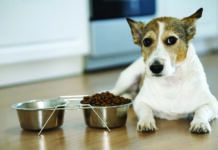“I got Indiana when I was still living with my parents,” says Kristen Heinze. The shepherd mix weighed “about 52 pounds,” she says. “She had never been a good eater. When I took her for dog training, it was very hard because I couldn’t find any food she was willing to do a trick for.”
Then, after Mr. Heinze had Indiana for a year and a half, she moved from her parents’ farm “into town.” That’s when the already quite lean Indiana lost 5 pounds — 10 percent of her body weight.
“When we lived on the farm she had a lot more access to things to eat,” Ms. Heinze says: “road kill, horse poop — you name it, she ate it. But the house in town has just a little yard. There was no more free access. I called my sister, and we talked about it.”
Ms. Heinze’s sister is Cailin Heinze, VMD, DACVN, a veterinary nutritionist at Tufts Cummings School whose life’s work is to treat dogs and other companion animals who need help with nutrition. She is also a member of Your Dog’s editorial board.
“My sister was worried,” Dr. Heinze says of her younger sibling. “On the Body Condition Scale, Indiana had been a 4 out of 9 in the first place — quite lean, but not too thin. A 4 or 5 is ideal body weight. She had gone down to a 3, however.” It meant you could feel her ribs too easily and even see them a bit. The tops of the bones on her lower back were visible, too, and her pelvic bones were becoming prominent.
Does Your Dog Appear Underweight or Losing Weight?
“The majority of the dogs we see who aren’t eating enough calories are undereating because they have considerable health problems,” Dr. Heinze says. “In our clinic, we don’t see too many healthy dogs who aren’t eating what they should. So if a dog is consistently losing weight and the vet thinks the animal is underweight, we rule out medical issues. A sick dog who doesn’t take in enough calories is going to get worse much faster if she doesn’t get the energy and nutrients she needs. While a healthy dog can generally recover from a few weeks of too little food or even complete starvation, that’s not true for a sick dog. Getting too thin with a systemic disease is a lot harder to come back from than getting too thin when healthy.”
Medical problems that can cause a dog to eat too little include everything from tooth or gum pain to kidney disease, heart disease, intestinal disease, certain cancers, and parasites. The nutrition treatment depends on the diagnosis. Tooth pain, for instance, might be solved with a root canal or a tooth extraction, and the dog can go back to her usual diet. Something progressive like kidney disease, on the other hand, is going to necessitate a more involved approach.
Of course, with kidney disease, “we treat the underlying condition,” Dr. Heinze says, “but there’s not a lot we can do to improve appetite as the disease progresses.” Dogs with kidney disease, especially as it advances, often feel nauseated, and the disease may also affect their sense of taste.
“Sometimes changing a flavor can help,” Dr. Heinze reports. “A dog, like a person, may associate the last food they ate before feeling nauseated with feeling sick, whether or not that particular food had anything to do with it. So trying a new flavor might increase a dog’s willingness to try what’s in her bowl.
“We also add palatability enhancers like a little bit of honey or fruit yogurt, apple sauce, or maple syrup or even butter. You don’t want to add sodium- and protein-rich foods to the diet of a dog with kidney disease because too much of these nutrients could exacerbate the condition. So something like lunchmeat, which is high in both protein and sodium, wouldn’t be a good option, but sweet things or fats may be useful. You’ve got to make sure the palatability enhancer doesn’t worsen the illness that’s causing the loss of appetite.”
In some cases, Dr. Heinze says, if you try different palatability enhancers on a sick dog’s food, or try different diets, or even make a homemade diet under a veterinary nutritionist’s supervision and the pet still won’t eat, “we can prescribe drugs that can increase appetite.” One of those is mirtazapine, an anti-depressant for people that may help a dog who’s not eating enough to eat more. Drugs will rarely get a dog with a really poor appetite to eat enough to meet all of her energy needs, but may be helpful if the dog is eating 75 to 90 percent of her daily needs and just needs a bit of a boost.
When a Dog’s Refusal to Eat is a Psychological Rather than a Medical Problem
While most of the dogs who come to Tufts because they’re underweight have serious diseases, “we do see a very small proportion of pets who don’t have apparent health problems but are still not eating well,” Dr. Heinze says. It’s at that point that you have to consider a psychological issue. More often than not, it’s the owner’s.
“Frequently, owners teach their dogs to be picky,” comments Dr. Heinze. “It seems to happen most frequently with little dogs.” Specifically, what the owners teach their pets, often by excessive placating, is that the pets call the shots. “So,” Dr. Heinze explains, “the dogs end up training the people in the household that they don’t want to eat what the owner wants to feed, and they hold out — often longer than the owner will. They have major willpower. So the owner keeps trying new foods, and the dog learns that she has the upper hand in food pickiness.” In other words, “that pickiness is learned from the actions of the owner rather than being inherent,” Dr. Heinze says. Refusing to eat when hungry “doesn’t make sense in the grand scheme of self-preservation.” Animals of any species are not born unwilling to give into hunger; they have to be taught that if they hold out, something more delectable, more to their liking, will be served.
“As soon as a healthy dog turns up her nose at a food you offer and you respond by offering something else right away,” Dr. Heinze says, “you have begun creating a monster.”
Dr. Heinze is clear that she does not mean a dog is supposed to be fed food she clearly does not like. “Sometimes,” she says, “for a dog who is not eating well and does not have a medical problem, it’s okay to try a gravy or other flavor enhancer to make the diet more appealing, with a goal of weaning those extras away.” It’s also okay to try a new food, especially one higher in calories so less of it needs to be eaten each day. But what you don’t want to do is become a short-order cook who has to try to figure out from meal to meal what your dog might feel like eating. “I don’t have a problem if an otherwise healthy dog misses two or three meals,” she says.
We should note that sometimes it’s not learned pickiness that keeps a dog from eating but nervousness. “It’s pretty rare, but we’ve had some owners so anxious about their dog’s food intake that the dog picks up on the anxiety and can’t eat,” Dr. Heinze reports. “I remember one owner in particular we had like this. The solution was to get another person in the household to start feeding the dog. The pet went from eating poorly for months to eating very reasonable, healthful amounts of the food served.”
The Picky Eater Dog
Okay, so what was going on with Kristen Heinze’s shepherd mix Indiana, who was losing weight but was not one of those dogs who kept holding out for something better — Ms. Heinze didn’t kowtow to her — and also was not anxious about food? She also was not sick with some disease that needed to be diagnosed.
“Maybe she isn’t happy in her new home,” Ms. Heinze had thought. “You start putting your psychological whatever onto your pet,” she relates. But that wasn’t it.
Her parents noticed that once their daughter left the farm, the barn cat’s food was lasting much longer. “Cat food is definitely her favorite,” Ms. Heinze says. “She’ll pick that over anything else.” But she was no longer getting any; thus, the weight loss.
“She just isn’t very food motivated,” big sister Dr. Heinze says.
The solution was to find Indiana a commercial diet that was higher in calories so she didn’t have to eat as much of it. “We also made sure she liked the taste of it,” Dr. Heinze says.
In addition, the food bowl is now down on the floor for only 20 minutes. “She used to have a bowl for free eating all day,” Ms. Heinze comments. But these days, if she doesn’t eat, “the bowl gets picked up, anyway. It allows her to build up an appetite. She’ll skip a meal here and there—maybe a couple of times a month. That’s perfectly fine. She is up to 51 pounds right now, and she is 14 years old.” That is, the problem happened a dozen years ago and was resolved fully with no reversal.
People Tend to Think Healthy Dog Weight is Underweight
Ms. Heinze says that while Indiana is now a healthy weight, “when people see her they still think she’s underweight.” That’s a common problem these days. The dog population is becoming so overweight — just like the human population — that people are used to seeing dogs that are too heavy and thereby misperceive healthy-weight dogs as too thin. Even dog breeds that are naturally thin are often mistaken for too lean (a very fit greyhound, for instance, will have a body condition score that’s lower than what would be acceptable in a different breed).
For that reason, Dr. Heinze says, before you start trying to feed your dog more food or different food in the belief that she is underweight, take her to the veterinarian for a body condition screening. Not all dogs eat enthusiastically, she says, and furthermore, “lean is not too thin.”




